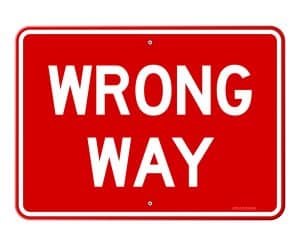The Devastation of Wrong-Way Accidents
 One of the most terrifying experiences you can have on the road is seeing headlights coming directly at you on a one-way road. Whether a wrong-way driver is lost, distracted, or driving under the influence, they can cause tragic and fatal head-on collisions – according to a study by AAA, hundreds each year. Learn more about wrong-way accidents, why they happen, and steps drivers can take to avoid them.
One of the most terrifying experiences you can have on the road is seeing headlights coming directly at you on a one-way road. Whether a wrong-way driver is lost, distracted, or driving under the influence, they can cause tragic and fatal head-on collisions – according to a study by AAA, hundreds each year. Learn more about wrong-way accidents, why they happen, and steps drivers can take to avoid them.
The Federal Highway Administration (FHWA) describes wrong-way driving crashes as:
One in which a vehicle traveling in a direction opposing the legal flow of traffic on a high–speed divided highway or access ramp collides with a vehicle traveling on the same roadway in the proper direction…
They report 428 traffic fatalities in 2018 resulting from wrong-way crashes, up from 415 in 2017. These numbers are also part of a data analysis released by the AAA Foundation for Traffic Safety earlier this year, noting the increase in wrong-way accidents across the country.
Said Dr. David Yang, executive director of the AAA Foundation for Traffic Safety, “Wrong-way crashes on divided highways are often fatal as they are typically head-on collisions. And unfortunately, as the data shows, fatalities from these crashes are on the rise.”
What causes wrong-way accidents?
Researchers looked at data from a variety of traffic safety sources to analyze what factors contributed most to wrong-way car accidents, and three stood out the most: alcohol impairment, older age, and driving without a passenger.
Alcohol impairment
Dr. Rob Molloy of the National Transportation Safety Board (NTSB) tells AAA, “Alcohol impairment is, by far, the single most significant factor in the majority of wrong-way driving crashes, which unfortunately has not changed since the NTSB issued its Wrong-Way Driving special investigation report in 2012.” In fact, the AAA study found that 60.1 percent – six out of every 10 – of wrong-way drivers involved in an accident had a blood alcohol concentration of 0.08 percent or higher.
Older age
Drivers over age 70 are also more at risk for wrong-way accidents than other motorists. Although older drivers typically spend less time on the road and drive fewer miles than younger people, AAA points out they are “over-represented” in wrong-way crashes. The Insurance Institute for Highway Safety notes that seniors with vision, memory, or cognitive impairments should self-limit or adjust their driving.
Driving without a passenger
Another statistic AAA reports is that nearly 87 percent of wrong-way drivers were traveling alone at the time of their accident, leading the organization to hypothesize that the presence of a passenger in the car can drastically cut down on the risk of an accident. According to the study, “Passengers may alert drivers that they are entering a one-way road, preventing them from entering the highway in the wrong direction, or alerting them to their error, helping the driver take corrective action before a crash occurs.”
The NTSB’s special investigation
As Dr. Molloy mentioned to AAA, in 2012 the NTSB issued a comprehensive investigation into wrong-way driving. Their findings were similar to those of the AAA report, and included the most common origins of wrong-way crashes and resulting head-on collisions:
- 59% of wrong-way drivers with a reported BAC had a “high BAC,” meaning it was at or above .15.
- The most common reason wrong-way accidents occur is when a driver mistakenly enters an exit ramp, makes a U-turn on a main road, or uses the emergency turnaround to make a U-turn (typically after missing an exit ramp).
- Wrong-way crashes happen more often at night and 78% occur between the hours of 6:00pm and 6:00am.
- The majority of wrong-way accidents happen on the weekends.
- Most wrong-way accidents happen in the lane closest to the median (the left-hand lane).
The NTSB also notes that, although they don’t happen often, when they do, wrong-way accidents tend to be severe or fatal crashes.
Preventing wrong-way accidents
A three-year program by the California Department of Transportation (Caltrans) and UC Davis piloted several prevention measures back in 2020, some of which proved highly successful. These included:
- Two-way reflective pavement markers, showing white or yellow to right-way drivers and red to wrong-way drivers.
- “Wrong Way” signs at different spacings.
- “Do Not Enter” signs with LED lights, flashing 24 hours a day.
- Active monitoring systems to detect wrong-way drivers using radar. When a driver enters a ramp the wrong way, another set of LED signs lights up, as well as sends a photos and an alert to the California Highway Patrol.
After installing the reflective pavement markers, Caltrans noted that wrong-way accidents in San Diego decreased by 44 percent. California continues to implement these measures, along with a few other states – hopefully with more, including North Dakota, getting on board soon.
Tips on avoiding a wrong-way driver
Although a wrong-way driver can appear out of nowhere, you can take some steps to avoid being involved in a serious accident. According to experts from various safety organizations, including AAA and the NTSB, when driving, keep the following in mind:
- Keep to the right when driving at night. Most wrong-way accidents happen in the left lane, closest to the median. This is because impaired or disoriented drivers believe they’re driving in the right, or correct, lane.
- When driving, keep a high visual horizon. This means looking far down the road to anticipate hazards or oncoming vehicles, giving yourself enough time to react in the event of an oncoming vehicle.
- Keep your headlights on at night and in inclement weather. Your lights can serve as a warning to any cars or trucks traveling the wrong way.
- If you do spot a wrong-way driver, get out of the way as quickly and as safely as possible. Call 911 as soon as it’s safe to do so and report the driver – you may save lives.
- Finally, never drink and drive.
The car accident attorneys at Larson Law can help if you or a loved one were hurt in a wreck or crash. We understand the physical and emotional toll a car accident can take, and we are prepared to work for the most successful outcome possible. We will fight for financial compensation on your behalf while you take the time you need to heal. Get in touch with us today about your case. Call us at 701-484-HURT, or complete our contact form to schedule a free consultation. We maintain offices in Minot, Fargo, and Bismarck.

Mark Larson is a Certified Civil Trial Specialist and Certified Civil Pre-Trial Specialist focusing on personal injury, car accidents, wrongful death, and oil field claims. Since 1979, Larson Law has served the injured throughout North Dakota. Read more about Mark V. Larson.
